Why do kindergarten children stop scribbling?
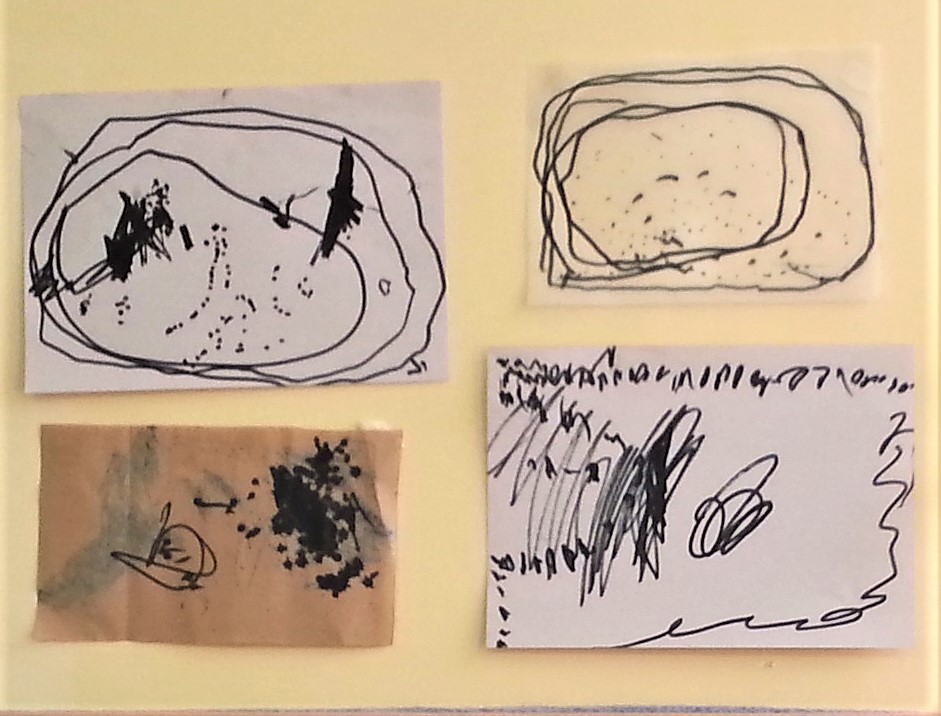
In many kindergartens in Israel, there is typical disturbing behavior of children. They stop drawing and scribbling, and if they do, they become frustrated and say their drawings are ugly.
In these kindergartens, coloring pages are given by the adults, parents, that sometimes draw an image the child requests to fill it with colors.
The outcome is that the child compares his drawings to his parent or teacher. Thus, the natural flow of scribbling and drawing of childhood is disturbed at a very young age, and they stop drawing.
A kindergarten teacher asked me to help her with this issue.
The question was: can we heal this?
Will children scribble again naturally, even after being exposed to coloring books? To copying?
Can we turn the wheels back?
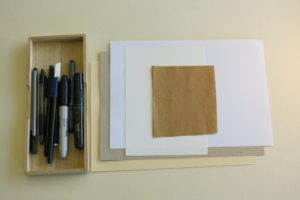
I came to the kindergarten that morning and prepared a suggestion for four: line-dot table. It contained: 2 kinds of paper and a few linear tools such as different sizes of markers, black pens, etc.
What is this? Asked the first child.
This is a scribble doodle table. Would you like to try it?
Very quickly, many wanted to scribble and create different lines. I hung the work immediately.

Why do you hang this? It is only a scribble.
I love scribbles, and there are so many of them! Can you discover a few?
It might also be interesting for other children to look at and perhaps have ideas about what they want to do.
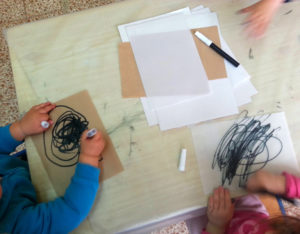
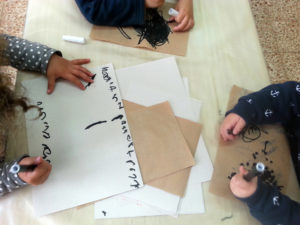
The meaning of this intervention:
Using black lines only encourages the brain to investigate shapes, lines, and dots. This brought the children immediately to their natural developmental phase to create from. The natural flow was revived. If there were colored pens it would most likely go into schemas as rainbows, hearts, flowers, etc.
The weeks followed, almost all children began doodling once again as their frustration around “ugly” drawings disappeared.
In that kindergarten, coloring books were not allowed, and the parents were notified, and many of them made some changes at home.
I think that part of this low self-esteem expression of even very young children is connected to how the western world understands education.
But, How can one measure curiosity, playfulness, joy, imagination, kindness, sharing?
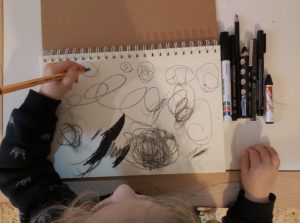
Liat Shmerling tried it with her child.
Written as a part of the #GrammerOfDrawing project.
Italian translation Roberta Pucci
English and Swedish – Suzanne Axelsson
Important reading:
Creative and Mental Growth – Viktor Lowenfeld
Viva scribbles and invented words!!!!!!!!!! Along with many possibilities for drawing with different types of pencils, markers, and more!
Lella Gandini inspired by the Reggio Emilia approach.
Thank you, Lella!
I remmbere you from my visits to Reggio, to the Loris Malaguzzi Center.
I am a friend of Roberta Pucci, who was an attelirista in the center.
I agree that many possibilities are important, and I love how you do it.
However, here in Israel, most educators need first to understand the basic…
You are all so much more advanced.
I am always so happy to see children’s art in your books and exhibitions.
I hope to meet you one day in Reggio Emilia.
They would not stop scribbling if they could have:
All experiences with pencils , chalks , markers or other tools that leave a trace are an invitation to discover more possibilities to explore and learn!
You are right – but -here in Israel we first need the basic…. in this kindergarten they were presented more tools later on after scribbling became “legitimate”
it is very constructive to exchange ideas and research about children for teachers
I agree with you and I love doing it – thank you very much for all the work you are doing 🙂
Very good story and wonderful images in th the story!!!!
Thank you very much from Lella Gandini
Geat informations and story I hope you will continue
I am working all the time in a huge group I mentor. I wrote you an e-mail about it and more.
Thanks for the encouragement!
VERY Butiful and interesting story it should be published in a well illustrated book!
Lella Gandini
I will send you something of mine that was translated into Italian by Roberta Pucci. The Spirit of Matter.
My new book was just published and is on Amazon:
The Good Enough Studio: Art Therapy Through the Prism of Space, Matter, and Action
I talk a lot about education as well. Reggio Emilia’s approach is mentioned in the book and is part of my way of thinking although I got to know it only in the last 8 years or so…
I love this post on scribbling, the way you showed scribbles and the way you set up your “scribbling doodle table”. I have been forwarding it . Thank you!
Thank you so much for your comment, Cathy!
It feels so good to know your work is meaningful to otheres in th world.